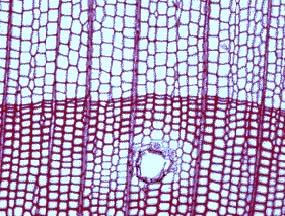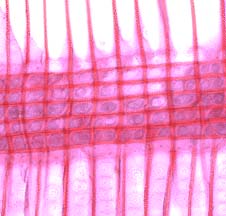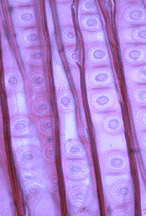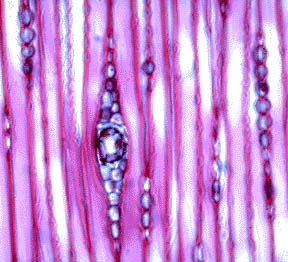Pinus (pine) wood sections
Examine the following three sections. Review Figures 26-20 and 26-21 in Raven 7th, pg 592-593; Raven 8th, figures 26-20 and 26-21, p. 628-629.
TRANSVERSE SECTION (CROSS-SECTION)
Transverse (cross) sections are important for determining the number of years old a tree is. The growth ring is the increment of growth per year. You can see the boundary between two years of growth here.
The wood of conifers is mainly made up of tracheids. It is homogeneous, and does not have many fibres; these characteristics makes the wood easy to work, thus it has been called “softwood”. Many conifers have resin ducts (canals) like the one in this section. Parenchyma cells often line such ducts. Parenchyma cells are also present in the rays of wood. These are more easily visualized in longitudinal sections.
LONGITUDINAL SECTIONS
In the longitudinal sections observe the thickened wall, tapered shape and pits of the tracheids. There are two types of longitudinal sections: radial and tangential. Radial sections are sections which are made along the radius. Tangential sections are made perpendicular to the radius.
Radial Section
The radial section provides you with the opportunity to see the two major “systems” of the xylem. The rays make up the radial system which is comprised mostly of parenchyma cells (although some species of pine have tracheids oriented in this direction); it is important for conduction in the horizontal plane. The axial system is composed mostly of tracheids which run in the vertical direction, important for conduction upward. The radial section is good for determining the pitting between the tracheids and the ray cells (cross-field pitting). The type of pitting can be a diagnostic tool in identification.
This radial section shows the pitting of the tracheids. These are bordered pits (review your lecture notes).
Tangential Section
The tangential section gives you more information, such as the structure of the ray. How many cells wide and high are the rays?
When you are trying to get a three dimensional idea of what wood looks like it is important to view these three different types of sections.




